Purebreds are "cultivated varieties" of an animal species achieved through the process of selective breeding. When the lineage of a purebred animal is recorded, that animal is said to be "pedigreed". Purebreds breed true-to-type which means the progeny of like-to-like purebred parents will carry the same phenotype, or observable characteristics of the parents. A group of purebreds is called a pure-breeding line or strain.

A landrace is a domesticated, locally adapted, often traditional variety of a species of animal or plant that has developed over time, through adaptation to its natural and cultural environment of agriculture and pastoralism, and due to isolation from other populations of the species. Landraces are distinct from cultivars and from standard breeds.
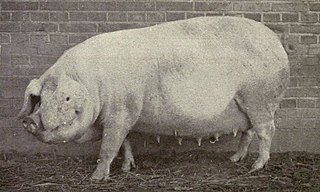
The Danish Landrace, Danish: Hvid Dansk Landrace, is a Danish breed of pig. It is of medium to large size, white in colour with a long body, fine hair, a long snout, and heavy drooping ears. There are two distinct varieties, the white and the piebald.

The American Landrace is an American breed of domestic pig. It is white in color, with a long body, fine hair, a long snout and heavy, drooping ears. Like all landrace pigs, it derives from the Danish Landrace.

The Hampshire pig is a domestic swine breed characterized by erect ears, a black body, and a white band around the middle, covering the front legs.

Pig shows are an event where pigs are evaluated for their quality. They are evaluated on a multitude of things which include composition, capaciousness, and skeletal integrity along with general appearance and conformation to their respective breed. Owners buy or raise their pigs from small piglets and spend time learning what the pig needs to make it the best possible. You can switch up compositions of a pig by simply changing what and how you feed them. Other names for a pig show include swine show and hog show. A pig show is frequently part of a larger agricultural show. During the agricultural show pigs may be shown, as well as cattle, goats, and sheep.

The Essex is a breed of domestic pig originating in the United Kingdom.
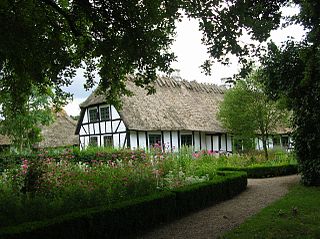
The Funen Village is an open-air museum located in the neighborhood of Fruens Bøge in Odense, Denmark.
The Estonian Bacon is a meat pig breed from Estonia. It was developed from local landrace by crossbreeding it with German, Danish and Swedish landraces. Its appearance looks similar to the Danish Landrace.
The Aksai Black Pied is a distinctively black and white spotted pig breed from Kazakhstan.
A landrace is a type of domestic animal or plant adapted to the natural and cultural environment in which it originated, with minimal selective breeding. Some have "landrace" in the names:

The Italian Landrace is an Italian breed of domestic pig. It derives from the Danish Landrace breed developed in Denmark at the end of the nineteenth century. Stock was imported into Italy after the Second World War. The breed has been selected principally for suitability for the production of prosciutto crudo. It is, after the Large White Italiana, the second-most numerous pig breed in Italy. The breed standard is issued by the Ministero delle Politiche Agricole Alimentari e Forestali, the Italian ministry of agriculture and forestry; the herdbook is kept by the Associazione Nazionale Allevatori Suini, the national pig-breeders' association.
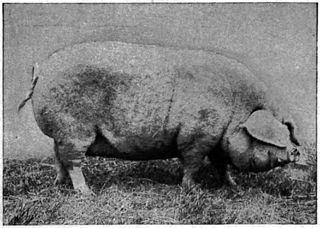
The Lincolnshire Curly Coat or Lincolnshire Curly-coated, also known as the Baston Pig, is an extinct British breed of domestic pig. It originated in, and was named for, the county of Lincolnshire, in the East Midlands. Like many other traditional pig breeds, it became rare after the Second World War. By 1970, it had disappeared. An older, still existing breed of similar looking pigs is the Hungarian Mangalica.
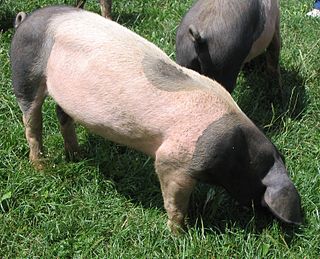
The Swabian-Hall swine is a breed of domestic pig originating from Schwäbisch Hall in Baden-Württemberg, Germany. It is a large pig, white in the centre with a black head and rear and narrow grey bands at the transition from white to black skin. They have large litters averaging more than nine piglets.

The British Landrace is a British domestic breed of pig and one of the most popular in the United Kingdom. It is pink with heavy drooping ears that cover most of the face and is bred for pork and bacon. The breed originated in the 1949 importation of 12 landrace pigs from Scandinavia — four boars and eight gilts. In 1950, the British Landrace Pig Society was formed and it opened a herd book for the first offspring born from the imported 12. They created the first pig testing scheme with a testing station at the village of Stockton-on-the-Forest in North Yorkshire.
Pork in Ireland has been a key part of the Irish diet since prehistory. Ireland's flora and fauna overwhelmingly arrived via a Neolithic land bridge from Great Britain prior to its submerging around 12,000 BP. When the very first hunter-gatherers arrived around 2,000 years later, the local ecosystem largely resembled that of modern Ireland.
The Lacombe is a breed of domestic pig native to Canada. Named for the Lacombe Research and Development Centre in Lacombe, Alberta, the breed was the first strain of livestock developed in the country.
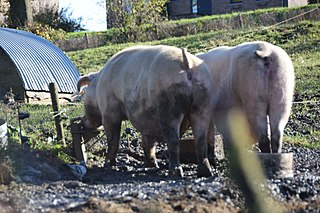
The Belgian Landrace, also known as the Improved Belgian, Belgian Improved Landrace, and the Belgian Lop-eared, is a breed of domestic pig from northern Belgium. It was created from importing English breeds and improving them until they were "graded up" to the German Improved Landrace from 1930 to 1945 and then breeding them with the Dutch Landrace in 1945. Other breeds were also incorporated into the bloodline to strengthen it, such as with ones from Luxembourg in 1955, Germany in 1971, and the Czech Republic in 1974. Used in many different countries, the Belgian Landrace is also one of the "four major commercial breeds" in France.

The Göttingen minipig is a breed of miniature pig. The Göttingen minipig is the smallest domestic pig breed known in the world; as an adult, they weigh around 35 kg (77 lb). Beside being known for their exceptionally small size, the Göttingen minipigs are known for their docile nature and very clean and well-characterized health status. Raising of this breed began in the late 1960s at the Institute of Animal Breeding and Genetics at the University of Göttingen, Germany, by crossbreeding the Minnesota mini-pig, the Vietnamese Pot-bellied pig, and the German Landrace pig. Göttingen minipigs are highly favored as pets, however, the breed was specifically developed for biomedical research. Today, they are extensively bred at four separate locations globally.
The Dutch Landrace pig is a standardized breed of domestic pig originating in the Netherlands. The breed was developed from the native landrace of pigs of the area, crossbred with strains from neighboring counties. The Dutch Landrace is considered "a meaty and efficient breed". The breed is unusually responsive to the halothane test, which can be used to weed out individuals with low projected survivability and meat production.












